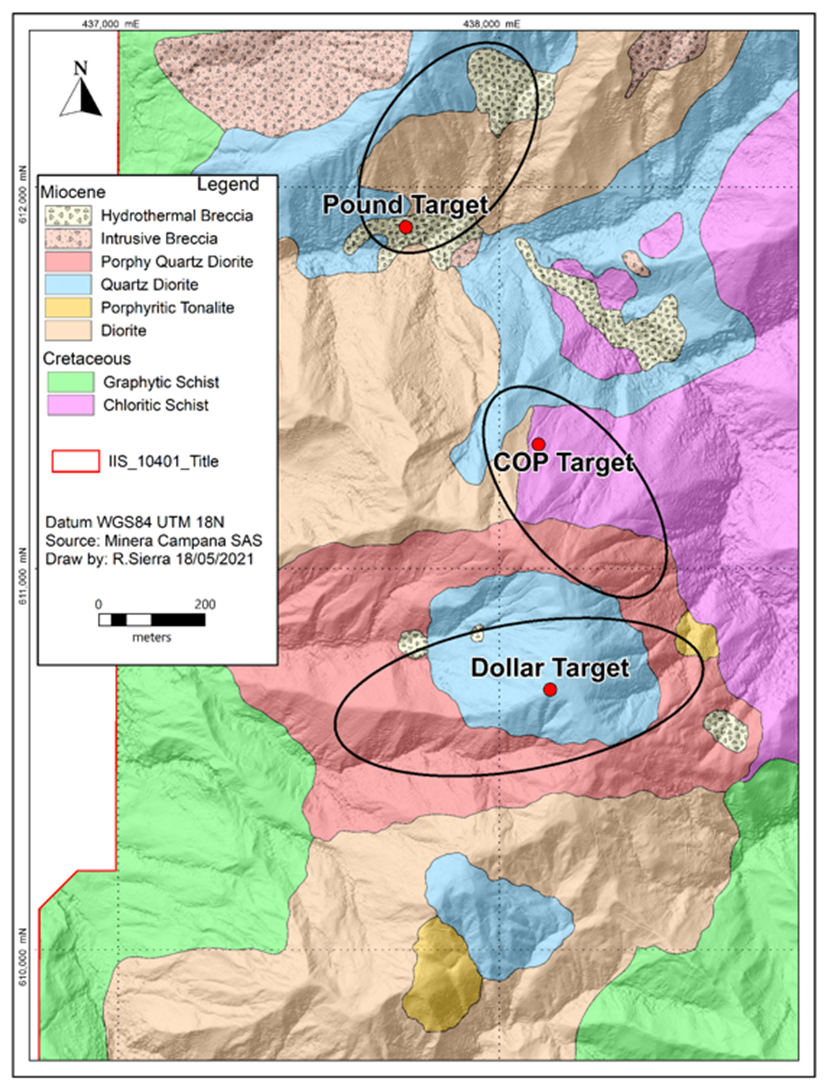Jun 4 2021
Collective Mining Ltd., an exploration and development company, has announced that a maiden 5000-m drill program is progressing on its fully-owned San Antonio project located in Caldas, Colombia.
 Plan View of the San Antonio Project Outlining Drill Targets. Image Credit: Collective Mining Ltd.
Plan View of the San Antonio Project Outlining Drill Targets. Image Credit: Collective Mining Ltd.
The objective of the 5000-m drill program is to first define the near-surface geometry of three targets and once they are defined, start testing the potential for concealed, multiple, mineralized porphyry and breccia bodies inside a region measuring around 2 x 1 km.
In this region, surface work has outlined molybdenum soil and anomalous gold values in relation to porphyry-related stockwork quartz veining, altered porphyry intrusive bodies, polymetallic veins and hydrothermal breccias.
The San Antonio project spans an area of 3,780 ha and is situated about 6 km northeast of the multi-million-ounce, development stage Marmato gold project of Aris Gold Corporation.
The San Antonio project is located inside the Middle Cauca Belt; a more than 250-km, north-south trending gold and base-metal belt that hosts numerous epithermal and porphyry discoveries comprising Zijin’s high-grade, multi-million-ounce Buriticá gold mine and the Anglogold-Ashanti porphyry deposits of Nuevo Chaquiro and La Colosa.
The assay outcomes from the maiden drilling program are expected to be available in the early fourth quarter of 2021.
Details
Three particular grassroots exploration targets have been defined by sampling, surface mapping, shallow scout drilling, geophysical modeling and soil geochemistry. These are called the Pound, Dollar and COP targets.
- A couple of diamond drill rigs are working on the project. So far, 1,857 m of scout drilling, to delineate the geometry of the Dollar target, has been finished. A pair of deeper penetrating drill holes to test for the prospective metalliferous parts of the Pound and Dollar targets are presently oncoming.
- The San Antonio project gains from conducive topography with about 600 vertical m of elevation change from the mountain peaks to the numerous flat-lying valleys. The topography is not overly steep and lends itself to numerous prospective infrastructure development situations in case an economic deposit is discovered in the days to come.
- The Dollar target is delineated by outcrops of quartz-magnetite stockwork as well as sheeted veins emplaced inside quartz diorite porphyry bodies in a region measuring 500 x 500 m. The vein systems are related to sericitic alteration. Shallow scout drilling was recently concluded to delineate the geometry of the stockwork bearing porphyry and it detected a robust overprint of yellow clay alteration, perhaps responsible for partial metal leaching. This fact accounts for the sporadic molybdenum and gold values observed in surface outcrops. Deeper drilling is currently ongoing from a high elevation at a local mountain peak so as to test the porphyry system at 600 m vertically under the surface. This hole is anticipated to intersect a robust magnetic anomaly defined by geophysical modeling, known to be part of the potassic metal-bearing porphyry center.
- Situated 1.2 km north of Dollar, the Pound target is delineated by polymetallic veins and hydrothermal breccias hosted inside diorite intrusive across a region of 600 x 350 m. On the southern border of this target region, outcrop exposures comprise epithermal vein systems inside a preserved lithocap of sophisticated argillic alteration that is superimposed on hydrothermal breccia bodies. Such rocks are known to reflect the preservation of the shallow levels of the porphyry system. A robust circular magnetic anomaly (MVI) is also situated about 600 to 900 m under the surface and is known to be the prospective porphyry source for the hydrothermal breccias situated directly above. The initial drill-hole, which is presently coring into the Pound target, will test the potential of both the porphyry and the hydrothermal breccias at depth.
- The COP target is situated 400 m north-northwest of the Dollar target and is delineated by extremely anomalous gold (up to 2.74 g/t) and molybdenum (8 to 108 ppm) in soils in relation to altered quartz veinlets and diorite porphyry across a region of 650 x 350 m. The surface expression of the COP target coincides with geophysical anomalies at 200 to 300 m depth which comprise IP chargeability and resistivity highs as well as a positive magnetic anomaly. COP has not been validated other than one historical borehole drilled just south of the target region, and returned an intercept of 99 m at 4.9 g/t silver and 0.42 g/t gold inside unmineralized country rocks partly intruded by mineralized porphyry quartz veins at a depth of 608 m downhole. The mineralization observed in the drill-hole is understood to be leakage from the COP target directly to the north.